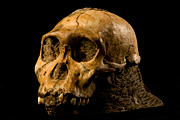- Number 311 |
- May 10, 2010
LLNL researcher aids in discovery of new species

Australopithecus sediba
Dan Farber of DOE's Lawrence Livermore National Laboratory in collaboration with an international team has discovered fossils of a new species of hominid, Australopithecus sediba, thought to be at least 2 million years old in an area of South Africa known as the Cradle of Humankind.
Farber's work involved describing the geological, geochronological, geomorphological and faunal context of the Malapa site—which holds the fossils of an adult and a juvenile of the new species.
Australopithecus is a genus of extinct hominids, made up of the gracile australopiths, and formerly also, the robust australopiths. The new fossils of Au. sediba reveal skeletons that are exceptionally well preserved, proving unique insight in the period when the earliest members of the genus homo evolved.
Using the Laboratory's Center for Accelerator Mass Spectrometry, Farber and a team of researchers were able to quantify the degree of post fossil landscape change. In other words, they were able to track the evolution of the landscape from where the fossils originally were deposited to where they were found in the present day. Using rare radioisotopes formed by the interaction of cosmic rays with rocks at the Earth's surface, Farber was able to provide a paleo-ruler by which he measured the amount of material lost since the time the fossil was deposited.
[Anne Stark, 925.422.9799,
stark8@llnl.gov]
